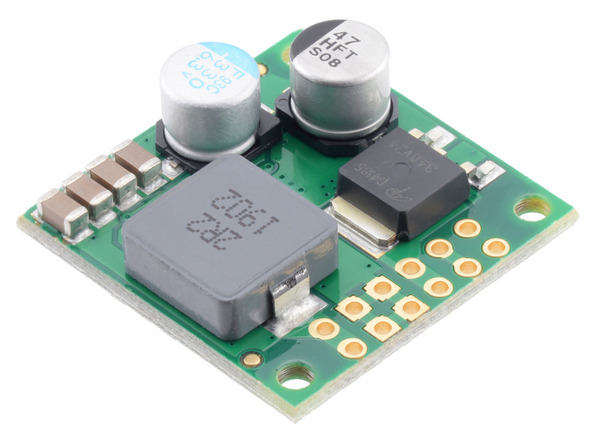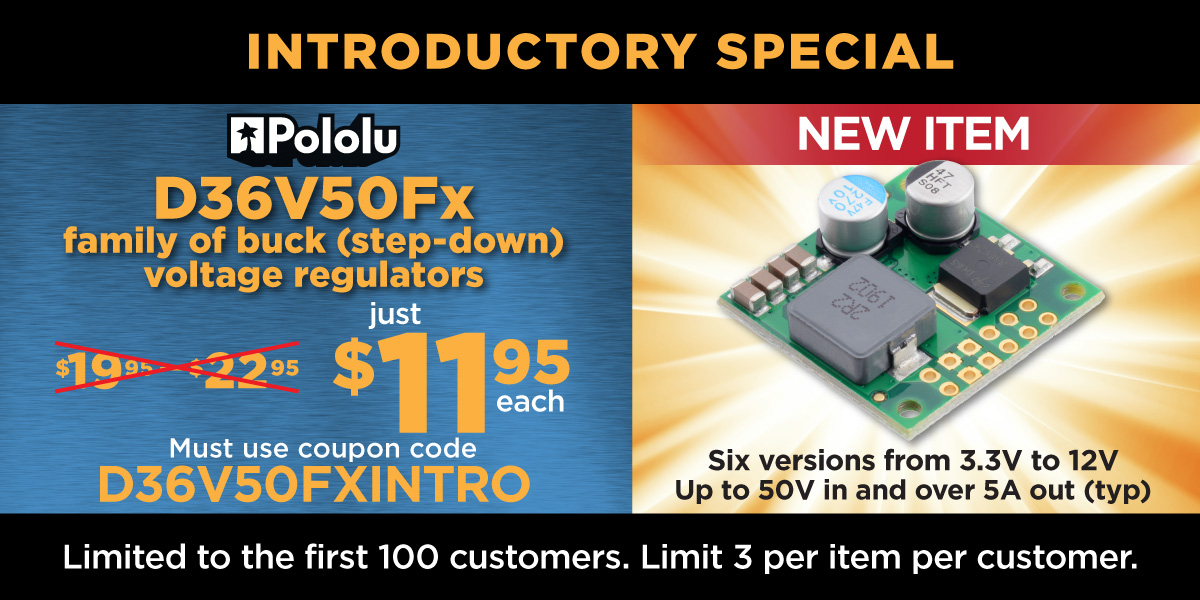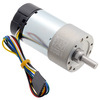Pololu Blog »
New products: D36V50Fx Step-Down Voltage Regulators
We have a new set of regulators to announce: the D36V50Fx family of step-down voltage regulators. Measuring a compact 1″ × 1″, these regulators support input voltages up to 50 V and can typically deliver around 5 A of current, although some versions can output much more under certain conditions.
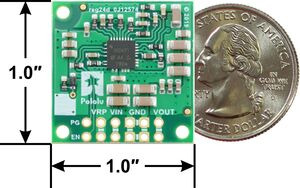 |
Step-Down Voltage Regulator D36V50Fx, bottom view with dimensions. |
|---|
The family consists of six fixed output voltage versions between 3.3 V and 12 V:
- D36V50F3: Fixed 3.3V output
- D36V50F5: Fixed 5V output
- D36V50F6: Fixed 6V output
- D36V50F7: Fixed 7.5V output
- D36V50F9: Fixed 9V output
- D36V50F12: Fixed 12V output
We can also manufacture a customized version for you here in our Las Vegas facility. For example, we could make regulators with a different output voltage that your project needs, or we could replace the 40 V reverse voltage protection MOSFET with a 20 V one for slightly improved efficiency if your input voltage will always be lower than 20 V. If you are interested in customization, please contact us for more information.
Comparison to other regulators
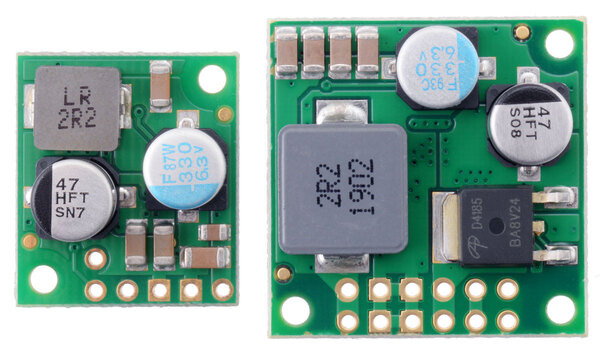 |
D36V28Fx and D36V50Fx Step-Down Voltage Regulators. |
|---|
The D36V50Fx regulators are larger and more powerful counterparts to the D36V28Fx family we introduced last year, with the same input voltage ranges and mostly similar characteristics. What distinguishes the two families in performance is that the D36V50Fx regulators can provide roughly double the output current! (At the high end of the input voltage range, the difference is generally less dramatic.)
 |
Comparison of the maximum continuous current of Step-Down Voltage Regulators D36V50Fx and D36V28Fx. |
|---|
And since many of our most popular regulators are 5 V modules, here is a graph comparing the new D36V50F5 (in blue) with two of our older high-power regulators, the D24V90F5 and the D24V50F5:
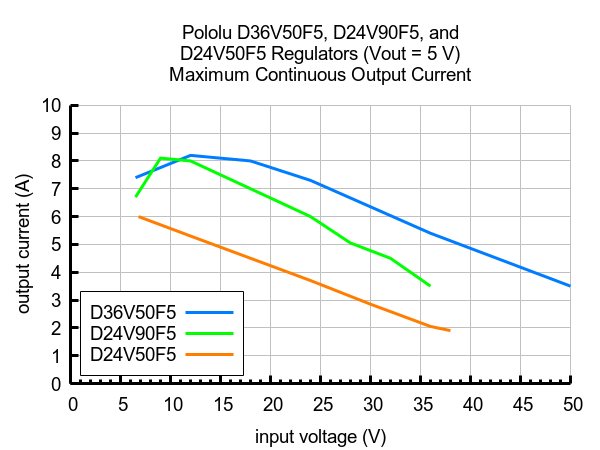 |
Comparison of the maximum continuous current of 5V Step-Down Voltage Regulators D36V50F5, D24V90F5, and D24V50F5. |
|---|
Introductory special
As usual, we are offering an extra introductory special discount on these new regulators, to help share in our celebration of releasing a new product. The first hundred customers to use coupon code D36V50FXINTRO can get up to 3 units of each version for just $11.95 each!
7 comments
since the comments on the D24V90F5 said that that regulator is not designed for low ripple and lower than "hundreds of mV", I assume this series (possibly all D35Vxxxx?) is better regarding output voltage ripple?
Is expecting 1% of Vout as ripple Vpk-pk realistic? I see that the switching frequency should be around ~880 kHz and there's a 2.2 uF inductor in the 5 Vout model. Which ceramics (capacity, voltage rating, number of capacitors in parallel) do you have on the output for filtering?
At least when going by the datasheet this should be realistic, at least when it is not in powersave/idle mode.
Also, is output regulation really so poor? 4%? Can you please clarify what you mean by that number? Is this the tolerance of the components resulting in an inaccurate output voltage (e.g. a 5V regulator may output 4.8V and the next one 5.2V). Or is this line regulation (difference in Vout vs Vin), or load regulation (difference in Vout vs Iout) or both?
Thanks.
What comments on the D24V90F5 regulator's ripple are you referring to? Our D36V28F and D36V5Fx families operate in power save mode and we generally expect the output ripple to be as high as 100-150mV. They are fairly noisy for our regulators. That is not quite at the 1% mark, but you could add additional capacitance to the output to reduce it. We do not share specifics about the components used on these boards, but if your purpose in asking about the output capacitors is to see about replacing them to get lower ripple, adding large capacitors to the output would be much more effective.
The 4% accuracy specification is separate and refers to the typical output voltage which takes into account tolerances in various components on the board. We do not think of 4% as "so poor", but that specification is there partly because we are not interested in specifying (guaranteeing) these any tighter. What do you think is a normal or reasonable accuracy?
By the way, I am not sure where 880kHz is from, but as we list in the features section of the D36V28Fx and D36V50F regulator pages, they switch at around 500kHz.
-Claire
my mistake, it was in the D24V50F5 blog post, not V90:
https://www.pololu.com/blog/417/new-product-5v-5a-step-down-voltage-regulator-d24v50f5#comment1J529
Just adding electrolytic caps to the output (even hybrid/polymer ones) will probably not help, as per the datasheet Vripple is dominated by ESR. Ceramics can have ESR as low as 1-2 mOhm, hence my asking about them, so adding bigger caps with tens of mOhm won't improve ripple at 500 kHz.
The 880 kHz came from me misreading the SMD resistor label. You are right, the switching frequency should be around 500 kHz.
You said these are fairly noisy for your regulators, but I don't see better alternatives at around 5A. The D24V50F5 output ripple was described with hundreds of mV, which sounds even worse. Am I missing something here?
Thanks for your help.
But RMS current over the input caps can be several amps!
Now you could argue that the chip switches at 500 kHz, but that is not the case in powersave mode. And powersave mode starts below half the ripple current, which could be 1A - 2A if my rough calculations are right (because the inductors are so small). The ripple current capabilities of the cap also drop with decreasing frequency.
Are you sure this part is adequate?
I have been using output ripple a bit sloppily in these comments, and what I meant is the total peak to peak output variations which includes noise from the rest of the circuit and environment. This total figure is what I expect to be 100-150mV and that is why I expect extra capacitance to help, though the actual output ripple will probably stay basically the same. We only have a few step-down regulators capable of outputting 5A; D24V150F5, D36V50F5, D24V50F5, and D24V90F5. As mentioned in the other comment we do not have the output ripple or noise well characterized, but I do not expect the other two to be much better than 100mV total output fluctuation.
The electrolytic capacitor used on the D36V50Fx input is rated for 50V, which is the maximum voltage we list for that regulator. Note that that is not a recommended nominal operating point. Also, we did test at 50V and the performance data (like maximum continuous output current) for 50V that is given on the D36V50Fx product pages was drawn from that testing. It is the end system user's responsibility to ensure that the input voltage does not exceed the limit, and a safe operating margin will depend on the details of each application.
As for the input ripple current, the danger there is in making the capacitor too hot for too long and reducing its lifetime. The input capacitor used on the D36V50Fx regulators does have a fairly high ESR, but in testing in a variety of operating points, it did not get unusually hot. We have used the same capacitor on the inputs of several regulators with comparable current capabilities and have sold thousands of units over almost a decade and have not had complaints about short lifespan or units that seems to suddenly stop working after prolonged use, so we think it gives us a good balance of cost, size, and performance.
-Claire
I've powered 48V DC cable through the house, is it safe to operate using your step-down voltage regulator which will run on the edge of maximum input voltage.
Thanks
Most power sources have some fluctuation on their outputs, so generally we do not recommend using a 48V source with these regulators with 50V maximum input voltages.
-Claire
